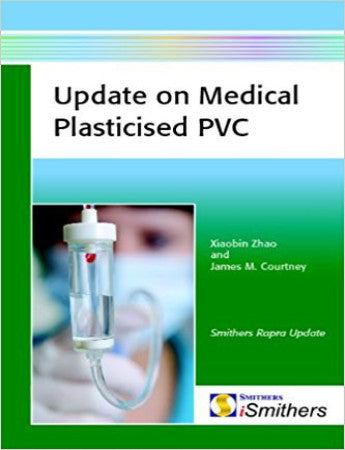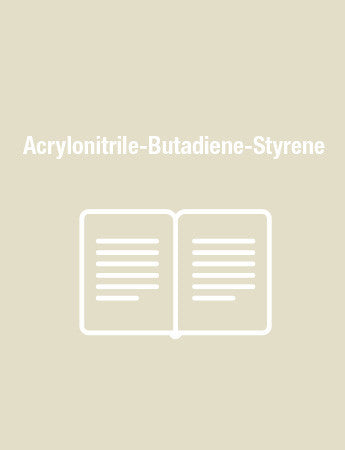Update on Medical Plasticised PVC
Poly (vinyl chloride) (PVC) is the most versatile of all the commodity polymers. It can satisfy a wide range of product function, safety, performance, and cost criteria.
Update on Medical Plasticised PVC considers the history of plasticised PVC in medical applications and the manufacturing and processing of plasticised PVC together with its properties are reviewed. The selection of plasticisers is a particular focus. In Chapters 4 and 5, and the blood compatibility of plasticised PVC is examined, based on the most recent information.
The regulatory requirements and environment concerns over the leaching of plasticisers and the generating of dioxins during the incineration of PVC-P medical products after use are discussed in detail.
Update on Medical Plasticised PVC will be of interest both to those who manufacture products using plasticised PVC, and to those who use the products and need to know about the using PVC in medical applications.
Update on Medical Plasticised PVC considers the history of plasticised PVC in medical applications and the manufacturing and processing of plasticised PVC together with its properties are reviewed. The selection of plasticisers is a particular focus. In Chapters 4 and 5, and the blood compatibility of plasticised PVC is examined, based on the most recent information.
The regulatory requirements and environment concerns over the leaching of plasticisers and the generating of dioxins during the incineration of PVC-P medical products after use are discussed in detail.
Update on Medical Plasticised PVC will be of interest both to those who manufacture products using plasticised PVC, and to those who use the products and need to know about the using PVC in medical applications.
1. Brief history of the medical applications of plasticised PVC
2. PVC-P formulation
2.1 PVC raw material
2.1.1 Suspension polymerisation
2.1.2 Emulsion polymerisation
2.1.3 Mass or bulk polymerisation
2.2 Additives
2.2.1 Plasticiser
2.2.2 Other additives
2.3 PVC-P formulation
2.3.1 Selection of plasticiser
2.3.2 PVC-P compounding
3. Properties of PVC-P
3.1 Mechanical properties
3.2 Low-temperature properties
3.3 Electrical properties
3.4 Surface properties
3.5 Permanence properties
4. PVC-P as a biomaterial
4.1 Introduction
4.2 Advantages of PVC-P
4.3 Disadvantages
4.4 PVC-P as a blood-contacting biomaterial
4.5 Other applications of PVC-P as a biomaterial
5. Blood compatibility of PVC-P
5.1 Introduction
5.2 Blood-biomaterial interactions
5.3 Factors influencing blood response to PVC-P
5.3.1 PVC formulation
5.3.2 Selection of plasticiser
5.3.3 Plasticiser concentration
5.3.4 Plasticiser surface level
5.3.5 Plasticiser surface distribution
5.3.6 Surface modification
5.3.7 Nature of application as devices
5.3.8 Blood nature and evaluation procedures
5.4 Plasticiser migration and regulation
5.4.1 DEHP migration and extraction
5.4.2 Toxicity of DEHP
5.4.3 Alternatives to DEHP
5.4.4 Alternatives to PVC-P as a blood-contacting biomaterial
5.4.5 New development of PVC-P biomaterials
5.4.6 Summary
6. Modification of PVC-P surface for improved blood compatibility
6.1 Physical treatment
6.2 Chemical treatment
6.3 Biological treatment
7. Future perspectives
7.1 Environmental and health concerns and regulatory issues
7.1.1 Sterilisation
7.2 Market needs
7.2.1 Market for PVC
7.2.2 Market for PVC medical devices
7.3 Emerging technology
Abbreviations
2. PVC-P formulation
2.1 PVC raw material
2.1.1 Suspension polymerisation
2.1.2 Emulsion polymerisation
2.1.3 Mass or bulk polymerisation
2.2 Additives
2.2.1 Plasticiser
2.2.2 Other additives
2.3 PVC-P formulation
2.3.1 Selection of plasticiser
2.3.2 PVC-P compounding
3. Properties of PVC-P
3.1 Mechanical properties
3.2 Low-temperature properties
3.3 Electrical properties
3.4 Surface properties
3.5 Permanence properties
4. PVC-P as a biomaterial
4.1 Introduction
4.2 Advantages of PVC-P
4.3 Disadvantages
4.4 PVC-P as a blood-contacting biomaterial
4.5 Other applications of PVC-P as a biomaterial
5. Blood compatibility of PVC-P
5.1 Introduction
5.2 Blood-biomaterial interactions
5.3 Factors influencing blood response to PVC-P
5.3.1 PVC formulation
5.3.2 Selection of plasticiser
5.3.3 Plasticiser concentration
5.3.4 Plasticiser surface level
5.3.5 Plasticiser surface distribution
5.3.6 Surface modification
5.3.7 Nature of application as devices
5.3.8 Blood nature and evaluation procedures
5.4 Plasticiser migration and regulation
5.4.1 DEHP migration and extraction
5.4.2 Toxicity of DEHP
5.4.3 Alternatives to DEHP
5.4.4 Alternatives to PVC-P as a blood-contacting biomaterial
5.4.5 New development of PVC-P biomaterials
5.4.6 Summary
6. Modification of PVC-P surface for improved blood compatibility
6.1 Physical treatment
6.2 Chemical treatment
6.3 Biological treatment
7. Future perspectives
7.1 Environmental and health concerns and regulatory issues
7.1.1 Sterilisation
7.2 Market needs
7.2.1 Market for PVC
7.2.2 Market for PVC medical devices
7.3 Emerging technology
Abbreviations
Dr Xiaobin Zhao obtained his BSc in Polymer Chemistry and MSc in Biomaterial Science in Nanjing University, China and PhD in Bioengineering Unit, University of Strathclyde in Glasgow. He was an associate of Scottish Network International (SNI) and has been working in the UK biomaterial industry since 1998.
Dr Zhao is the inventor of Double X-Linking Technology (DXL TM) for Mentor. He is a UK Chartered Scientist and Chemist. He is a Fellow of Royal Society of Chemistry, Professional Member of Institute of Materials in UK and Society for Biomaterial in USA. He has published more than 45 scientific papers, book chapters and gained numbers of patents on his name world widely. He holds visiting professorship in University of Strathclyde and Visiting Professorship in Lanzhou University in China.
Currently he is visiting Professor in Strathclyde University and Director of UK China Research Academy of Bioactive Molecules and Materials.
Dr Zhao is the inventor of Double X-Linking Technology (DXL TM) for Mentor. He is a UK Chartered Scientist and Chemist. He is a Fellow of Royal Society of Chemistry, Professional Member of Institute of Materials in UK and Society for Biomaterial in USA. He has published more than 45 scientific papers, book chapters and gained numbers of patents on his name world widely. He holds visiting professorship in University of Strathclyde and Visiting Professorship in Lanzhou University in China.
Currently he is visiting Professor in Strathclyde University and Director of UK China Research Academy of Bioactive Molecules and Materials.




